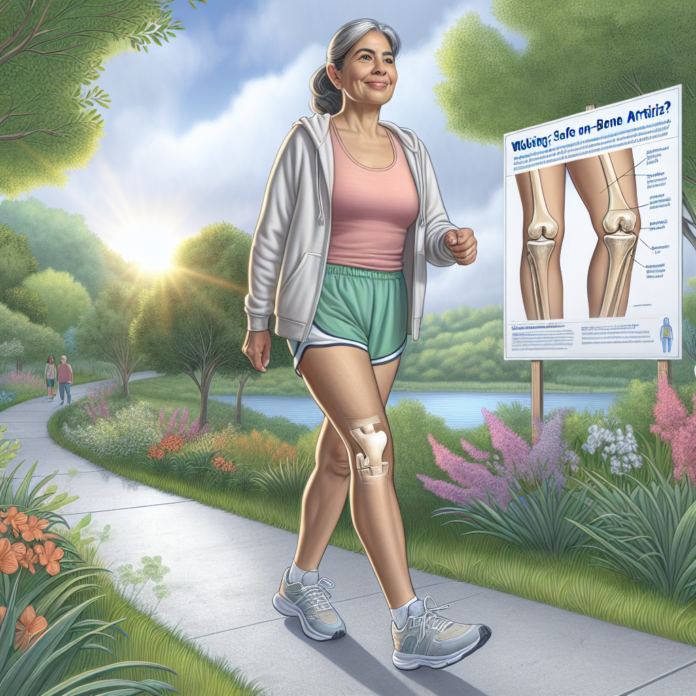In the world of orthopedic care, a persistent myth continues to circulate: the belief that walking for exercise is inherently detrimental to those suffering from bone-on-bone arthritis in the hips or knees. This recommendation, often dispensed by medical professionals, suggests that individuals with these conditions should refrain from such physical activities to avoid worsening their condition. However, in this eye-opening blog post, Dr. David Guyer, a triple board-certified orthopedic surgeon and sports medicine specialist, challenges this outdated notion. Drawing from the insights of his popular “Ask the Doctor” video series, Dr. Guyer explores the surprising benefits of walking and running even with advanced arthritis, debunking myths and providing guidance to those seeking to maintain an active lifestyle while managing joint health. Join us as we delve into the pros and cons of impact exercise for arthritis sufferers and uncover why this age-old advice might just be due for a reevaluation.
Understanding Bone-on-Bone Arthritis
Many individuals diagnosed with bone-on-bone arthritis in their knees or hips are advised against walking for exercise, often based on the premise that such activities might exacerbate their condition. However, it’s crucial to challenge this perspective and seek an informed, balanced view on the matter.
Firstly, it’s important to understand what “bone-on-bone” arthritis implies. This type of arthritis occurs when the protective cartilage between the bones wears down, causing the bones to rub against each other. This can lead to discomfort, swelling, and decreased mobility. However, the fear that walking might worsen this condition may not be entirely justified.
Evidence Supporting Walking for Arthritis
- Improves Cartilage Health: Contrary to the belief that impact activities like walking damage joints, recent studies show they may indeed be beneficial. The movement aids in circulating synovial fluid, which nourishes and lubricates the cartilage, potentially improving its resilience.
- Enhances Joint Functionality: Regular low-impact exercise, such as walking, can help maintain joint function and prevent stiffness. This is particularly essential for individuals with arthritis, as it can promote better range of motion and lessen pain over time.
- Supports Overall Health: Walking is an excellent exercise for cardiovascular health, maintaining a healthy weight, and improving mood. For arthritis patients, these benefits might outweigh the risks, especially when performed at a comfortable pace and with proper technique.
- Research Findings: Studies have shown that individuals who engage in regular walking or even running report lower levels of arthritis progression and diminished need for joint replacement surgeries compared to those who lead a sedentary lifestyle.
Tailoring Exercise to Individual Needs
It’s vital to note that every arthritis patient is unique, and what works for one person may not suit another. Thus, customization of exercise routines is key:
- Intensity and Frequency: Begin with short, manageable sessions of walking, gradually increasing duration and intensity as comfort levels improve. Listen to your body, and don’t push through severe pain.
- Alternative Exercises: On days when walking may not feel feasible, consider cross-training with non-impact exercises like swimming, cycling, or yoga to maintain physical activity without stressing the joints excessively.
- Consultation and Monitoring: Regular consultations with healthcare professionals can assist in crafting an exercise plan tailored to your specific condition and capabilities, ensuring you reap the maximum benefits without adverse effects.
Addressing Pain and Discomfort
For those experiencing persistent pain, there are strategies to alleviate discomfort and continue benefiting from walking:
- Proper Footwear: Invest in supportive, cushioned shoes designed for walking to minimize impact and provide comfort.
- Walking Aids: Utilizing aids such as canes or walking poles can help distribute weight evenly and reduce stress on affected joints.
- Pain Management Techniques: Incorporate practices like hot or cold therapy and over-the-counter pain relief as advised by a healthcare provider to manage symptoms effectively.
Debunking Misconceptions
The notion that walking inevitably leads to accelerated joint deterioration is largely rooted in outdated thinking. Many orthopedic professionals, including Dr. Guyer, emphasize that avoiding exercise can contribute to muscle weakness and decreased joint stability, possibly exacerbating arthritis symptoms rather than alleviating them.
It is crucial to differentiate between informed advice and myths that perpetuate inactivity in arthritis sufferers. Modern research and clinical observations suggest that staying active is beneficial, provided it’s done appropriately and with professional guidance.
Ultimately, incorporating walking into daily routines can be a valuable tool for managing arthritis symptoms and enhancing quality of life. By staying informed and consulting with medical experts, individuals can safely enjoy the benefits of walking without undue fear of worsening their condition.
In the ever-evolving field of orthopedic care, dispelling myths around exercise and arthritis is imperative. Dr. Guyer’s insights offer a refreshing perspective, encouraging patients to confidently engage in walking as a means of sustaining joint health and overall wellbeing.
Dr. David Guyer challenges the myth against walking with arthritis, highlighting benefits for joint health and debunking old beliefs. Embrace exercise safely!
